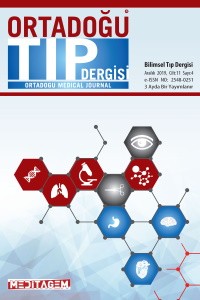Abstract
Turner sendromu en sık görülen cinsiyet kromozom anomalilerinden biridir. Turner sendromunun, konsepsiyondaki sıklığı yüksektir ancak bu konsepsiyonların çok büyük bir kısmı intrauterin dönemde mortalite ile sonuçlanmaktadır. Alopesi areata saç dökülmesi anlamına gelen her iki cinsiyeti de etkileyebilen bir hastalıktır ve dünya genelinde görülme sıklığı yaklaşık %1-2’dir. Alopesi areatanın bütün saç ve vücut kıllarındaki dökülmeler ile oluşan formu alopesi universalis olarak adlandırılır. Turner sendromu ve alopesi universalis birlikteliği literatürde nadir olarak bildirilmiştir. Bu olgu sunumunda Turner sendromu ve alopesi universalisin birlikte görüldüğü 45,X/46,X,i(X)(q10) karyotipli olgu tartışılmıştır.
References
- Kriksciuniene R, Zilaitiene B, Verkauskiene R. The current management of Turner Syndrome. Minerva Endocrinol. 2016; 41(1): 105-21.
- Akcan A.B. Turner Syndrome. Konuralp Tıp Dergisi 2013; 5(2): 53-61.
- Conteduca G, Rossi A, Megiorni F, Parodi A, ve ark. Single nucleotide polymorphisms in the promoter regions of Foxp3 and ICOSLG genes are associated with Alopecia areata. Clin Exp Med. 2014; 14(1): 91-7.
- Aktaş E, Aykol D. Aproaches in the treatment of alopecia areata. TÜRKDERM 2004; 39: 20-27.
- Akbaş E, Altintas Z.M, Celik SK, ve ark. Rare Types of Turner Syndrome: Clinical Presentation and Cytogenetics in Five Cases. Laboratory Medicine. 2012; 43(5): 197–204.
- Gianfaldoni S, Tchernev G, Wollina U, Lotti T. A Case of Alopecia Areata in a Patient with Turner Syndrome. Open Access Maced J Med Sci. 2017; 5(4): 493–496.
- Friedmann PS. Decreased lymphocyte reactivity and auto-immunity in alopecia areata. Br J Dermatol. 1981; 105(2): 145-51.
- Jabbari A, Petukhova L, Cabral RM, Clynes R, Christiano AM. Genetic basis of alopecia areata: a roadmap for translational research. Dermatol Clin. 2012; 31(1): 109–117.
- Tebbe B, Gollnick H, Muller R, ve ark. Alopecia areata and diffuse hypotrichosis associated with Ullrich-Turner Syndrome. Presentation of 4 patients. Hautarzt 1993; 44: 647–652.
- Bouayed Abdelmoula N, Portnoï MF, Amouri A ve ark. Turner syndrome female with a small ring X chromosome lacking the XIST, an unexpectedly mild phenotype and an atypical association with alopecia universalis. Ann Genet. 2004; 47(3): 305-13.
- Mortensen KH, Cleemann L, Hjerrild BE, ve ark. Increased prevalence of autoimmunity in Turner syndrome--influence of age. Clin Exp Immunol. 2009; 156(2): 205–210.
Abstract
Turner syndrome is one of the most common sex chromosomal abnormalities. The incidence of Turner’s syndrome is higher in conception, but the majority of these conceptions result in mortality in intrauterine period. Alopecia areata meaning hair loss is a disease that can affect both sexes, and its prevalence is around 1-2% in the world. Alopecia universalis is an advanced form of alopecia areata and it is characterized by the complete loss of hair on the scalp and body. The association of Turner syndrome and alopecia universalis has been reported rarely in the literature. In this case report, a case with alopecia universalis and Turner syndrome whose karyotype is 45, X / 46, X, i (X) (q10) was discussed.
References
- Kriksciuniene R, Zilaitiene B, Verkauskiene R. The current management of Turner Syndrome. Minerva Endocrinol. 2016; 41(1): 105-21.
- Akcan A.B. Turner Syndrome. Konuralp Tıp Dergisi 2013; 5(2): 53-61.
- Conteduca G, Rossi A, Megiorni F, Parodi A, ve ark. Single nucleotide polymorphisms in the promoter regions of Foxp3 and ICOSLG genes are associated with Alopecia areata. Clin Exp Med. 2014; 14(1): 91-7.
- Aktaş E, Aykol D. Aproaches in the treatment of alopecia areata. TÜRKDERM 2004; 39: 20-27.
- Akbaş E, Altintas Z.M, Celik SK, ve ark. Rare Types of Turner Syndrome: Clinical Presentation and Cytogenetics in Five Cases. Laboratory Medicine. 2012; 43(5): 197–204.
- Gianfaldoni S, Tchernev G, Wollina U, Lotti T. A Case of Alopecia Areata in a Patient with Turner Syndrome. Open Access Maced J Med Sci. 2017; 5(4): 493–496.
- Friedmann PS. Decreased lymphocyte reactivity and auto-immunity in alopecia areata. Br J Dermatol. 1981; 105(2): 145-51.
- Jabbari A, Petukhova L, Cabral RM, Clynes R, Christiano AM. Genetic basis of alopecia areata: a roadmap for translational research. Dermatol Clin. 2012; 31(1): 109–117.
- Tebbe B, Gollnick H, Muller R, ve ark. Alopecia areata and diffuse hypotrichosis associated with Ullrich-Turner Syndrome. Presentation of 4 patients. Hautarzt 1993; 44: 647–652.
- Bouayed Abdelmoula N, Portnoï MF, Amouri A ve ark. Turner syndrome female with a small ring X chromosome lacking the XIST, an unexpectedly mild phenotype and an atypical association with alopecia universalis. Ann Genet. 2004; 47(3): 305-13.
- Mortensen KH, Cleemann L, Hjerrild BE, ve ark. Increased prevalence of autoimmunity in Turner syndrome--influence of age. Clin Exp Immunol. 2009; 156(2): 205–210.
Details
| Primary Language | Turkish |
|---|---|
| Subjects | Health Care Administration |
| Journal Section | Case report |
| Authors | |
| Publication Date | December 1, 2019 |
| Published in Issue | Year 2019 Volume: 11 Issue: 4 |
e-ISSN: 2548-0251
The content of this site is intended for health care professionals. All the published articles are distributed under the terms of
Creative Commons Attribution Licence,
which permits unrestricted use, distribution, and reproduction in any medium, provided the original work is properly cited.

